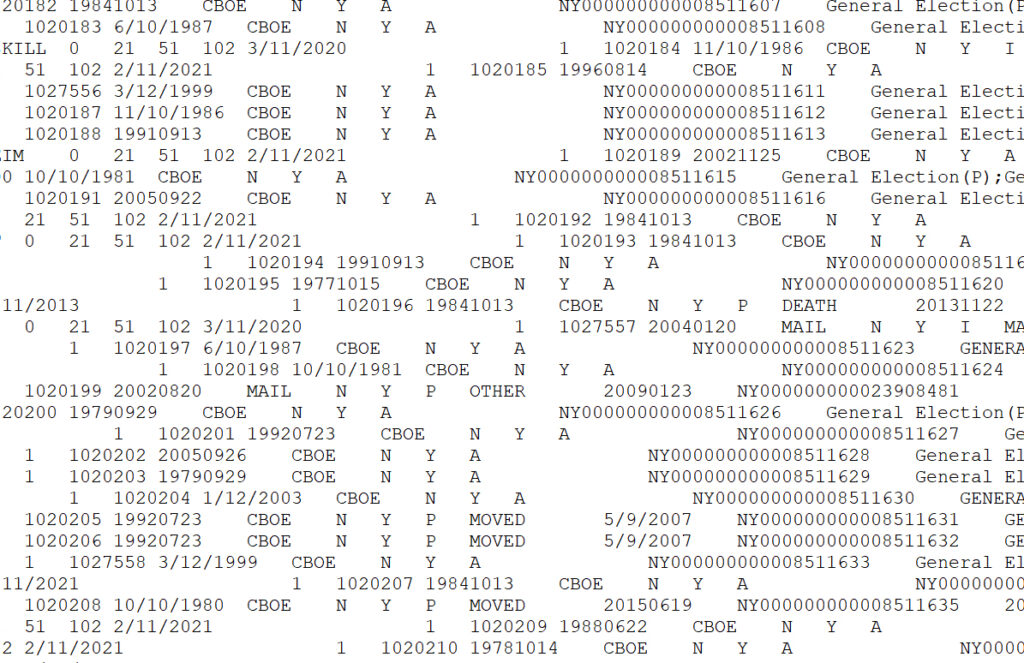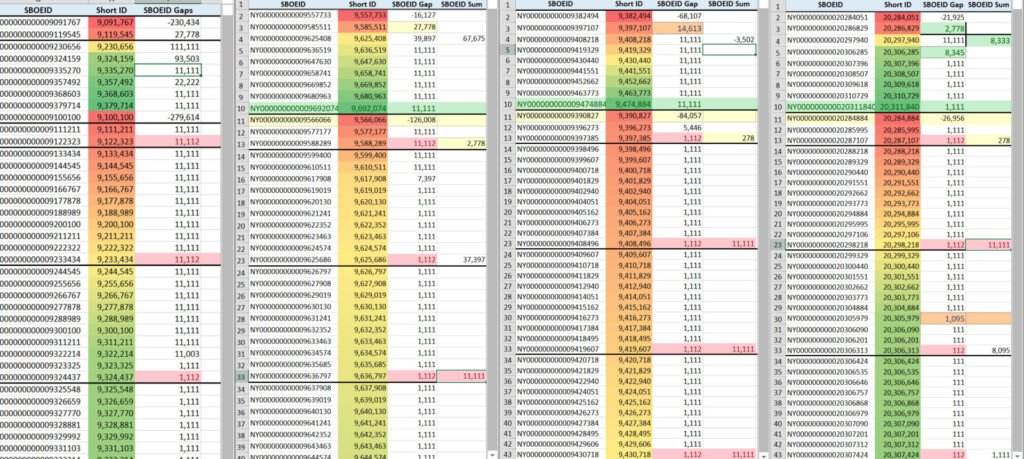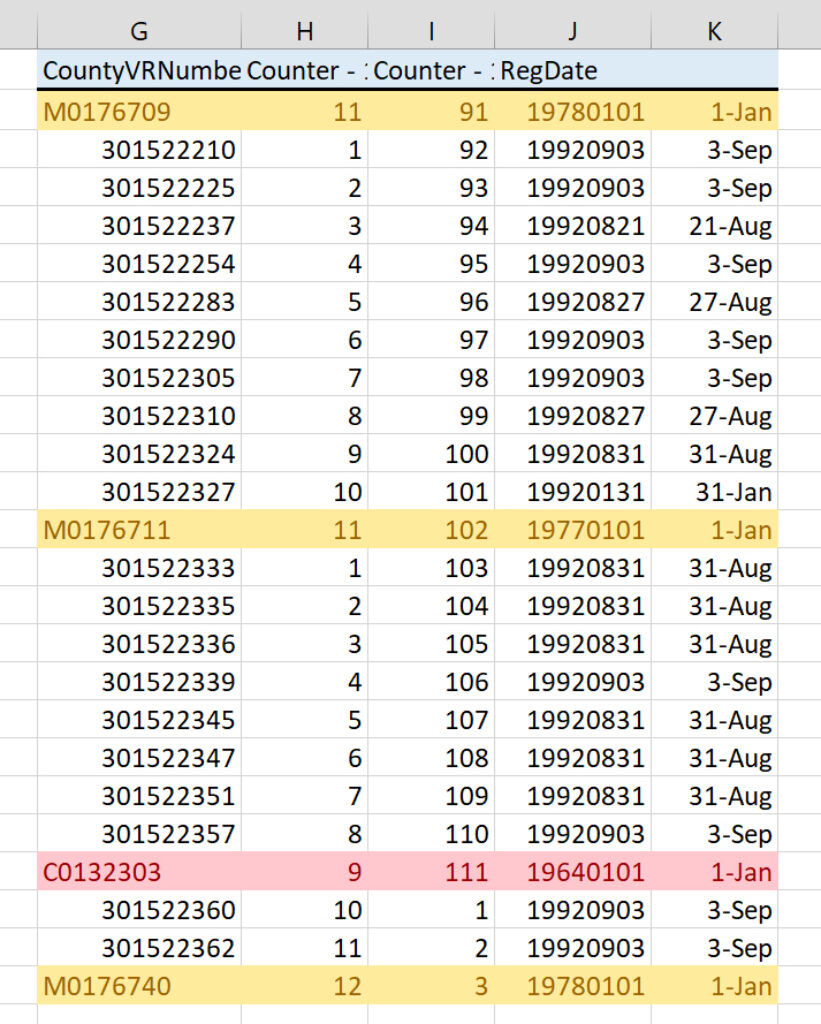BY | 13 August 2022
Sometimes, you run into something so out of place that you have to ask yourself, how did that get there? A boat in the desert, A fossilized battery, crop circles, and now, New York’s voter rolls.
New York Citizens Audit (NYCA) is an all volunteer group of individuals who have been studying the 2020 General Election since last August. After a year’s worth of effort, they have made some impressive findings. They have discovered hundreds of thousands of cloned voter records, examples of identity theft, discrepancies between official vote counts, over a hundred thousand registered voters without an address, and more.
Go Ad-Free, Get Exclusive Shows and Content, Go Premium Today – $1 Trial
Today, an NYCA representative appeared on True the Vote’s “vital strategy session,” “The Pit,” and dropped something truly strange: There is a pattern embedded in the identification numbers assigned to voters.
How did it get there, and why?
The pattern, dubbed “The Voter Matrix” by NYCA, creates an alternate structure within the voter rolls. The details are complicated but the effect is simple: It makes nefarious manipulation of records possible.
The Voter Matrix presents the possibility that no amount of “cleaning the rolls” or “purging records” can fix the problem, because the Matrix can regenerate phantom voters all day long.
The pattern is well-hidden. It is unlikely that anyone would have found it in the normal course of business. Experts consulted for this article were amazed that it was found at all. Last year, NYCA submitted a Freedom of Information Law (FOIL) request to the New York Board of Elections for New York’s voter rolls. A few months later, the BOE delivered the rolls on a DVD. If one were to open the nine-gigabyte text file and look at it as-is, the pattern would be invisible, though it is sitting right there in plain sight, as seen in the image below.

The size and format of the voter roll document make it extremely difficult to view directly. Instead, it must be converted to another format. It cannot be opened in Excel because it is too large. Database software can deal with it, provided it is resident on a powerful enough computer.
Workers at the local BOE in any given county likely do not have the database on their computer, as they instead login it on a network. All of these things interfere with viewing the document in the state it was in when delivered to NYCA. To make it worse, the pattern is highly dependent on the idiosyncratic sort order the data appears in on the original disk. Once anyone filters or sorts the data, something they are likely to do every time they interact with the database, the pattern is destroyed and cannot be recovered.
NYCA decided to call the pattern “The Voter Matrix” because it restructures state and county voter ID numbers (SBOEID and CID numbers, respectively) into a well-defined and complex matrix. Programmers working with NYCA have managed to reproduce it. According to them, it is mathematically sophisticated. Whoever designed it was good at his job and likely very well-paid.
Viewed from within a database app, the Matrix is only visible if the original sort order hasn’t been destroyed (unlikely), a sufficient number of consecutive records are selected for viewing, and the records selected are the right records (also unlikely). It would help if you were looking for the pattern. If not, you might miss it for that reason alone.
It is possible to see parts of the Matrix after destroying the original sort order but it would be a misleading shadow of the original. The reason is that you wouldn’t see the right pattern. You would see a pattern and it is interesting but the Matrix itself is gone.
The image below shows a small section of the Matrix as seen in four different New York Counties:

The Matrix is created by first linking the sort order of SBOEID (State Board of Elections ID) numbers to the sort order of CID numbers. That way, if you sort the SBOEID numbers by themselves, you will destroy the Matrix. To see the pattern in the SBOEID numbers, you have to sort by CID numbers instead. It’s like turning your steering wheel right to turn left: not intuitive.
The second step generates SBOEID numbers a pre-determined space apart. For instance, the numbers “1” and “12” are 11 numbers apart. That gap value between the numbers is the hidden key to the Matrix. The gap values literally don’t exist anywhere in the database. There is no field for them. If you want to see them, you have to calculate the values yourself, between every pair of 20,765,242 records. If you haven’t sorted the records correctly, all of your calculations will be wrong and the pattern will be either destroyed (not visible) or deformed (incorrect).
And by the way, if you sorted the records at all, you’ve destroyed at least part of the Matrix. The key to this booby-trap embedded in the Matrix are alphanumeric CID numbers.
Not all CID numbers are alphanumeric. Some are, some aren’t. The problem posed by these numbers is that no spreadsheet or database program will sort them together. However, they must be to preserve the Matrix. This is because the alphanumeric CID numbers are interlaced with numeric values. The only way to position them in the right places is to literally place them there.
This can only be done if you know where they belong to begin with. That can only be accomplished by using the custom app that put them there, which you can see below.

The CID numbers have at least two other peculiarities. The first is that letters in the alphanumeric CID numbers are assigned specific numeric values. The letter “M”, for instance, stands for an 11 or 12 unit gap between each consecutive M. The letter “C” represents the end of a group of 111 or 112 numbers, and the letter “B” stands for a gap of 11,111.
The second peculiarity is that about 75% of all alphanumeric CID numbers were registered on New Year’s Day. In New York County alone, over 121,000 of 143,000 alphanumeric CID numbers have a January 1st registration date. That is over 10% of the active registered population of New York County. Other counties are similar.
NYCA has identified five distinct matrices in New York’s 62 counties. One, dubbed “The Spiral,” is used in 52 counties. That is the matrix used for examples in this article. There are also the “Reverse Spiral” (five counties), “The Metronome” (four counties), “The Blur” (one county), and “The Tartan” (40% of each county in the state). Each Matrix has built-in variations that interfere with any attempt to easily understand or visualize what it is doing.
For instance, the Spiral Matrix starts by separating each consecutive number by 11,1111. Then, it punctuates every tenth “11,111” with “11,112” (11,111 +1). After this has cycled a few times, it switched to “1,111” and “1,112” every tenth record. This runs for hundreds of entries, then thousands, then switches to “111” and “112”, and so on. In between, it throws in odd numbers that seem out of place, like “27,778” or “833”. All of these numbers belong to a family of numbers known to mathematicians as “RepUnits”.
A RepUnit is any number of 2 or more digits where each digit is the same as all the rest. For instance, the numbers “11”, “111”, “1,111”, and “11,111” are all RepUnits of “1”. In the same way, “22”, “333”, and “4,444” are RepUnits of the numbers 2, 3, and 4, respectively. The numbers 27,778 and 833 are not RepUnits themselves but they are both related to RepUnits of “1”. The number 27,778 is 25% of 111,111 (rounded) and 833 is 75% of 1,111 (rounded. NYCA calls these numbers “quarter RepUnits” and a “triple quarter RepUnit”. Quarter and triple quarter RepUnits are used to mark the end of a group of 10 RepUnits and the start of the next highest RepUnit, like changing from 1,111 to 11,111.
The Matrix is built into the voter roll records of every county in New York. This is a fact. Any person with access to the rolls can see for themselves as long as they know what to look for. It is very hard to find but once it is known, very easy to see. These two qualities are essential to any successful implementation of steganography, and that is what this is.
“Steganography” is similar to cryptography, where a message is disguised by changing its content based on a set of rules. For instance, exchanging the number “11,111” with the letter “B”, and the number “111” with the letter “C”. That is simple cryptography. Steganography goes a step further, by hiding the fact that there is a message. The Spartan king Demaratus once scraped the wax off of a writing tablet, wrote a message to his city on the wood underneath, then replaced the wax and sent it past guards outside a city. They did not suspect the blank tablet contained a warning to inhabitants of the city and let it through their checkpoint.
Voter rolls are public. They cannot be hidden without violating public access laws. Moreover, they cannot be encrypted (at least, not obviously) without violating those same laws. If there is a need to hide information within the voter rolls, the only way is to use steganographic methods. The question is why?
NYCA tried to identify a legitimate purpose for the Matrix. Their top contenders were all related to database optimization. The problem is that no legitimate scheme would include falsifying data in the database, and that is what New Year’s Day registration dates look like. This, they hasten to add, isn’t simply because the dates are on their face false, it is because those dates are linked to essential components of the Matrix: the alphanumeric CID numbers. The linkage of those dates with those specific numbers makes a legitimate explanation unlikely.
As for nefarious reasons, one immediately came to mind. By restructuring voter identification numbers into a well-defined matrix structure, it becomes possible to place, track, and interact with phantom registrations. Is that what is going on?
One source I consulted for this article not only agreed that is what is happening, he said he’d seen it before, with the same patterns made out of RepUnits. According to him, he saw it in the Middle East. The purpose, according to him, was to “control elections. I never expected to see it in America.”
The Matrix found within New York’s voter rolls closes the loop started with ballot trafficking, as seen in the movie “2,000 Mules.” For trafficked ballots to have any effect, they must be counted. To prevent an overcount, the vote count must match the voter count. To do that, phantom registrations are needed.
We know from 2,000 Mules that fake ballots were counted in the 2020 General Election. We know from research conducted by NYCA that large numbers of phantom voters are present in the voter rolls. The only piece missing from this puzzle is a way to clandestinely access the phantom voter records.
The problem is similar to that faced by a pirate captain. He has stolen a ship full of treasure and must hide it. He buries the treasure on several small islands. If he doesn’t make maps to identify where the treasure is buried, he may as well have thrown it into the sea. The same problem exists here. The phantom voter records must be hidden so they cannot be discovered by others but they must be easy to find for the people who put them there.
The Voter Matrix can solve that problem. It creates a hidden structure within the ID numbers. That structure can be accessed by an external app that understands the Matrix. It uses the repositioned numbers to determine which can be safely interacted with (phantoms) and which cannot (legitimate records). This is what NYCA has found. Anyone with access to the voter rolls can see it.